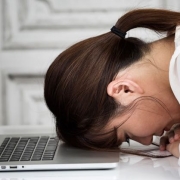You Can Combine Tradition and Technology to Support Your Health—Here’s How
Every few months there are advances in smart phone technology. Every few weeks science seems to come up with new, exciting discoveries. Every few hours a new idea enthralls the internet. That makes it seem like the world is accelerating ever faster towards a sci-fi future.
As advanced as every voice-activated, algorithm-driven gadget is, the basics of human health have thankfully remained mired in antiquity—a constant in a whirlwind of change. This relative stasis allows you to look back at what’s worked from ancient cultures to help shape your healthy lifestyle today.
For the sake of your continued well-being, learn to lean on the wisdom of traditional approaches from around the world. That doesn’t mean tossing that new fitness tracker or trashing your meal-planning app. You’ll see below how to mix ancient wisdom with the tech tools of modernity to keep you living your best life.
Seek Balance
The concept of balance has remained relevant throughout ages—unlike the dedicated practice of it. You frequently hear about balanced diets, work-life balance, and so on. But it’s mostly lip service.
Seeking balance is a goal that requires action and attention. Instead of abiding so much imbalance, use the tools available to sustain a harmonious, healthy lifestyle.
- Set timers to define boundaries around tasks so they don’t bleed into time for yourself or your family.
- Utilize phone functions that snooze notifications for periods of time or have dedicated hours of powering devices off so you can focus on being present and mindful.
- Organize your days to provide the balance you want—the structure and intention of the action are both helpful.
- Track your food intake using an app to see an unvarnished view of what you’re eating each day.
- Turn to programs or online health coaches to help you settle into a balanced diet that works for you.
- Remember to balance your energy output with revitalizing self-care activities—from meditation to practicing hygge (the philosophy of cozy comfort).
Avoid Excess
Balancing your life means avoiding excess, so the two goals feed into each other. You can’t balance your work and family life if you’re working 12-hour days. And a balanced diet isn’t possible with an excess of sugary snacks tipping the scales—literally and figurative.
But excess is exceedingly hard to avoid. This era of abundance means many cultures are swimming in excess information, excess calories, excess material possessions, and more.
There are solutions, though. Some of the work you do balancing your life will help tamp down excess, as well. Here are a few other ways to moderate many aspects of your modern existence:
- Track calories in and out to avoid caloric excesses that can lead to weight gain.
- If you drink alcohol, do so in moderation—accomplished through a tracking app, or good, old-fashioned limits imposed through self-control and help from your friends.
- Declutter your physical spaces to make them healthier places to be.
- Use meditation apps or other mindfulness tips to shed some of the stresses crowding your headspace, stealing your focus, and sapping your energy.
- Limit your screen time (smart phone, tablet, or TV) whenever possible. There are apps for that, too.
Take the Holistic Approach
Being detail-oriented is a great quality to have. It helps at the office and at home. However, tracking details and focusing on minutiae often obscures the big picture.
Details haven’t always bedeviled humanity, though. Ancient Eastern philosophies focus on a holistic approach to life—and to health. Traditional Chinese health approaches treat the body as a whole, while Western practices tend to focus more closely on the specifics of individual systems.
But the absolute truth—a fact spanning all traditions—is that the body is a hyper-connected machine. Zooming out to see these connections and keeping an eye on the big picture of your body and your overall well-being can help keep you healthy and happy.
Being more holistic means servicing your total body health, and supporting all your pillars of wellness. Use the smart phone apps at your disposal to find whole-body workouts, schedule time for all aspects of your health, and design your diet to serve your overall health goals.
Practice Self-Massage Techniques
Massage is a ticket to a realm of luxurious relaxation. Muscle tension and stress melt away with each minute, leaving you a puddle of pure tranquility at the end. But sometimes you’re stuck at work with tension rippling around your body, wringing out your energy and calm with each wave. And there isn’t a massage table or fluffy robe for miles.
Ancient traditions—with their self-massage techniques—can make a world of difference for muscle relaxation and calm feelings. You don’t have to be born with magical massage hands to find relief when a spa appointment isn’t possible.
Here’s what you can do:
- Only massage areas of tension or mild pain. Massaging the wrong area (like one that is experiencing sharp pain) in the wrong way can make matters worse.
- Use pressure on areas of tightness and utilize circular motions to work out knots.
- Try using two fingers, a knuckle, or your thumbs—whatever is most comfortable for the area you’re working on.
- Limit yourself to about 30 seconds on each area you massage.
- Start light on the pressure and never press as hard as you can.
- Use foam rollers, tennis balls, or massage gadgets to enhance your ability to work out tension. (Only use massagers and rollers as directed and instructed by the manufacturer or a health professional.)
- Find videos or tutorials for guided exploration of different self-massage techniques.
- Book time with a quality professional masseuse for help dealing with problem areas.
View Food as a Functional Part of Your Overall Health
The focus on diet has stayed strong throughout the centuries. Unfortunately, the spotlight today tends to be on weight-management or aesthetics—not as much on how food can support your overall health.
Maintaining a healthy weight is important. And concentrating on your diet actually follows along with ancient traditions. The aim is just slightly different.
Traditional Chinese nutrition—and other long-lasting philosophies—tend to view food as functional for health, imbuing more intentionality on dietary decisions. This means ingredients are chosen to help support specific aspects of health, while also maintaining your holistic well-being.
So start reframing your relationship with food and beverages to include functionality along with considerations like taste, calories, and macronutrient content. You can learn more about traditional Chinese nutrition and then apply your knowledge by using technology to make meal planning and your diet easier to shape and then follow.












